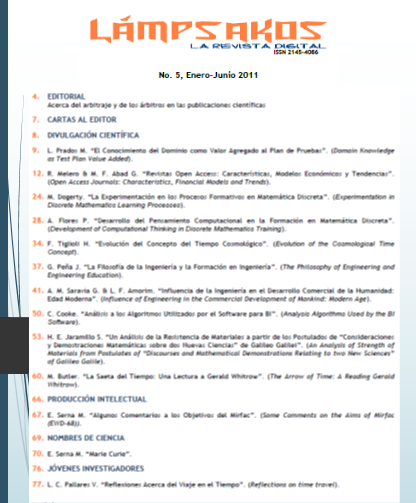Desarrollo del Pensamiento Computacional en la Formación en Matemática Discreta
DOI:
https://doi.org/10.21501/21454086.815Abstract
Este documento se refiere al desarrollo del pensamiento computacional en la formación en matemáticas discretas. En primer lugar, se detallan cuatro componentes principales del pensamiento computacional: pensamiento abstracto, pensamiento lógico, pensamiento modelado y pensamiento constructivo. En segundo lugar, se describe parte del contenido de las matemáticas discretas, que tiene estrecha relación con el pensamiento computacional, a través de un ejemplo de aplicación correspondiente. Por último, se hace un mapeo de las unidades de conocimiento de las matemáticas discretas con los detalles subsecuentes del pensamiento computacional.Downloads
Download data is not yet available.
Downloads
Published
2011-06-15
How to Cite
Flores, A. (2011). Desarrollo del Pensamiento Computacional en la Formación en Matemática Discreta. Lámpsakos, (5), 28–33. https://doi.org/10.21501/21454086.815
Issue
Section
Case report and/or divulgation articles not derivaded of a research
License
In accordance with national and international copyrights, as well as publishing policies of "Fundación Universitaria Luis Amigó" and its Journal "Lámpsakos" (indexed with ISSN : 2145-4086), I (we ) hereby manifest:1. The desire to participate as writers and submit to the rules established by the magazine publishers.
2. The commitment not to withdraw the manuscript until the journal finishes the editing process of the ongoing issue.
3. That article is original and unpublished and has not been nominated or submitted together in another magazine; therefore, the rights of the article in evaluation have not been assigned in advance and they do not weigh any lien or limitation for use.
4. The absence of conflict of interest with commercial institution or association of any kind
5. The incorporation of the quotes and references from other authors, tending to avoid plagiarism. Accordingly, the author affirms that the paper being published do not violate copyright, intellectual property or privacy rights of third parties. Morover, if necessary there is a way of demonstrating the respective permits original copyright to the aspects or elements taken from other documents such as texts of more than 500 words, tables, graphs, among others. In the event of any claim or action by a third party regarding copyright on the article, the author (s) will assume full responsibility and come out in defense of the rights herein assigned. Therefore, for all purposes, the Journal "Lámpsakos" of the "Fundación Universitaria Luis Amigó" acts as a third party in good faith.
6. In the event of the publication of the article, the authors free of charge and on an exclusive basis the integrity of the economic rights and the right to print, reprint and reproduction in any form and medium, without any limitation as to territory is concerned, in favor of the Journal "Lámpsakos" of the "Fundación Universitaria Luis Amigó".








